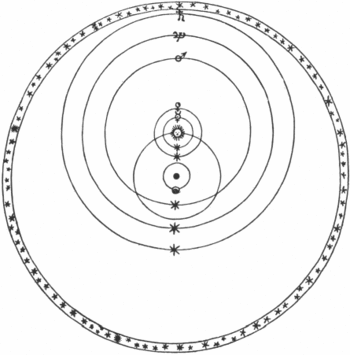Tychonic system: Difference between revisions
Jump to navigation
Jump to search

imported>Caesar Schinas m (Bot: Update image code) |
mNo edit summary |
||
| Line 6: | Line 6: | ||
In his model, the Sun place is the centre of the [[orbit]]s of five [[planet]]s ([[Mercury]], [[Venus]], [[Mars]], [[Jupiter]], and [[Saturn]]) and the Earth remains static, being the centre of the [[Sun|Sun's]] and the [[Moon|Moon's]] orbits. Above all, remains the cristaline [[stellar sphere]]. | In his model, the Sun place is the centre of the [[orbit]]s of five [[planet]]s ([[Mercury]], [[Venus]], [[Mars]], [[Jupiter]], and [[Saturn]]) and the Earth remains static, being the centre of the [[Sun|Sun's]] and the [[Moon|Moon's]] orbits. Above all, remains the cristaline [[stellar sphere]]. | ||
[[Category:Suggestion Bot Tag]] | |||
Latest revision as of 11:00, 31 October 2024
The Tychonic system or Tychonic Universe is the model of universe developed by the observational astronomer Tycho Brahe in response to astronomical and cosmological discussions that took place in his time. His model incorporates many of the geometrical advantages of the Copernican System (specially the movement of inner planets) without the physical and cosmological problems that came from it - in particular, the problems of a moving Earth.
In his model, the Sun place is the centre of the orbits of five planets (Mercury, Venus, Mars, Jupiter, and Saturn) and the Earth remains static, being the centre of the Sun's and the Moon's orbits. Above all, remains the cristaline stellar sphere.
